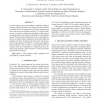Free Online Productivity Tools
i2Speak
i2Symbol
i2OCR
iTex2Img
iWeb2Print
iWeb2Shot
i2Type
iPdf2Split
iPdf2Merge
i2Bopomofo
i2Arabic
i2Style
i2Image
i2PDF
iLatex2Rtf
Sci2ools
ICASSP
2011
IEEE
2011
IEEE
Region-adaptive probability model selection for the arithmetic coding of video texture
In video coding systems using adaptive arithmetic coding to compress texture information, the employed symbol probability models need to be retrained every time the coding process moves into an area with different texture. To avoid this inefficiency, we propose to replace the probability models used in the original coder with multiple switchable sets of probability models. We determine the model set to use in each spatial region in an optimal manner, taking into account the additional signaling overhead. Experimental results show that this approach, when applied to H.264/AVC’s context-based adaptive binary arithmetic coder (CABAC), yields significant bit-rate savings, which are comparable to or higher than those obtained using alternative improvements to CABAC previously proposed in the literature.
ICASSP 2011 | Multiple Switchable Sets | Probability Models | Signal Processing | Video Coding Systems |
| Added | 20 Aug 2011 |
| Updated | 20 Aug 2011 |
| Type | Journal |
| Year | 2011 |
| Where | ICASSP |
| Authors | Kenneth Vermeirsch, Joeri Barbarien, Peter Lambert, Rik Van de Walle |
Comments (0)

